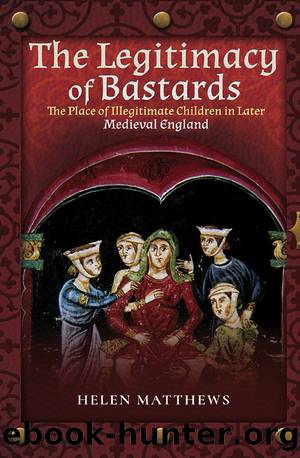The Legitimacy of Bastards by Helen Matthews

Author:Helen Matthews [Matthews, Helen]
Language: eng
Format: epub
Tags: Social Science, Sociology, Marriage & Family, History, Europe, Great Britain, Norman Conquest to Late Medieval (1066-1485), Social History
ISBN: 9781526716576
Google: j04IEAAAQBAJ
Publisher: Pen and Sword
Published: 2019-03-30T00:46:28+00:00
This is obviously of little value as evidence of the nature of the transaction between Vescy and Bek. Dugdale cited his source for the Bek story as Lelandâs excerpts from the Scalachronica of Thomas Gray. Gray, a Northumberland knight born c. 1310, wrote his chronicle more than forty years after these events took place and is unlikely to have had direct knowledge of the events he described. Another late source, The Chronicle of Alnwick Abbey, did not contain the same allegation; however, since the Percies had been in situ as lords of Alnwick and patrons of the abbey for over sixty years by the time of writing, this omission may not be significant. An account written closer to events can be found in the chronicle attributed to Robert Graystanes, a monk of Durham, who wrote that Bek was entrusted with it to the use of Vescyâs young son, but sold it to Henry Percy.
As a monk at Durham, the author was well-placed to know about events, but the poor relationship between the bishop and priory at the time means that he cannot be regarded as an unbiased observer. What the chronicle evidence does show is that rumours circulating among those who were not particularly well-disposed towards the bishop cast him in a bad light by claiming that he had betrayed Vescyâs trust by depriving the innocent young bastard son of his inheritance. William Vescy of Kildare is portrayed as the victim. The point of the anecdote was the supposed venality of the bishop in betraying his trust for personal gain rather than the action of William de Vescy in trying to provide for his bastard son.
Some individuals showed a remarkable lack of concern for public opinion about illegitimacy. This in itself may suggest that bastardy was not such a great social stigmaâperhaps less of an embarrassment than the humble origins that the Pastons were at such pains to conceal. The most striking example of this is Sir William Plumpton. His son Robert was the product of a second, clandestine marriage to Joan Wintringham. Since the marriage reportedly took place in the 1450s and was not made public until 1468, Sir William does not appear to have been unduly worried about any consequences for his son of being presumed a bastard. In the meantime, his subterfuge had ensured good marriages for the granddaughters who were presumed to be his heiresses. In January 1464 Sir William had received £400 from Brian Rocliffe for the marriage of Margaret Plumpton, the elder, to his son John, and £333 from Henry Sotehill for the marriage of his son John to her younger sister Elizabeth. The problems later experienced by Robert Plumpton arose not from perceptions of illegitimacy as such, but from the actions of the aggrieved husbands of Margaret and Elizabeth, once his legitimacy had been certified and Sir William had disposed of his estates in Robertâs favour. It is worth noting, however, that the clandestine marriage only became public because Sir William had been
Download
This site does not store any files on its server. We only index and link to content provided by other sites. Please contact the content providers to delete copyright contents if any and email us, we'll remove relevant links or contents immediately.
Room 212 by Kate Stewart(4111)
The Crown by Robert Lacey(4109)
Endurance: Shackleton's Incredible Voyage by Alfred Lansing(3850)
The Iron Duke by The Iron Duke(3642)
The Rape of Nanking by Iris Chang(3518)
Killing England by Bill O'Reilly(3459)
Joan of Arc by Mary Gordon(3262)
Say Nothing by Patrick Radden Keefe(3065)
I'll Give You the Sun by Jandy Nelson(2843)
Hitler's Monsters by Eric Kurlander(2735)
Shadow of Night by Deborah Harkness(2722)
Margaret Thatcher: The Autobiography by Thatcher Margaret(2687)
Mary, Queen of Scots, and the Murder of Lord Darnley by Alison Weir(2679)
Darkest Hour by Anthony McCarten(2649)
Blood and Sand by Alex Von Tunzelmann(2610)
Red Famine: Stalin's War on Ukraine by Anne Applebaum(2467)
Eleanor & Park by Rainbow Rowell(2396)
The One Memory of Flora Banks by Emily Barr(2349)
Book of Life by Deborah Harkness(2267)
